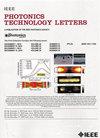Fabry-Perot Interferometer Curvature Sensor Based on Microwave Photonic Filter Technique
IF 2.3
3区 工程技术
Q2 ENGINEERING, ELECTRICAL & ELECTRONIC
引用次数: 0
Abstract
In this letter, we propose and experimentally demonstrate an approach to performing high-resolution and temperature-insensitive idea of a Fabry-Perot interferometer (FPI) curvature sensor utilizing microwave photonic filter (MPF) technique. A section of the capillary fiber is spliced between a single-mode fiber and a core-less fiber to form the air-gap FPI. The bending deformation of the FPI leads to changes in the fringe visibility (V) and free spectral range (FSR) of the interference pattern, which are converted into the changes in peak power and central frequency of the corresponding MPF. Consequently, the bending curvature can be recovered by tracking the frequency shift or the magnitude change. The experimental results show that the peak of the MPF decreases non-linearly with the increased curvature and a second-degree polynomial curve is fitted to predict the relationship. Compared with the fringe visibility change in optical domain, the peak power change of the MPF is enhanced by ~5 times. Meanwhile, the wavelength shift has a linear relationship with the curvature, and the sensitivity of 19.5 pm/m−1 is achieved in the curvature range of 3.3065-9.0552 m基于微波光子滤波技术的法布里-珀罗干涉仪曲率传感器
在这封信中,我们提出并实验证明了一种利用微波光子滤波器(MPF)技术实现高分辨率和温度不敏感的法布里-珀罗干涉仪(FPI)曲率传感器的方法。在单模光纤和无芯光纤之间拼接一段毛细管光纤以形成气隙FPI。FPI的弯曲变形导致干涉图样的条纹可见度(V)和自由光谱范围(FSR)的变化,转化为相应的MPF的峰值功率和中心频率的变化。因此,可以通过跟踪频移或幅度变化来恢复弯曲曲率。实验结果表明,峰值随曲率的增加呈非线性下降,并拟合了二阶多项式曲线来预测峰值与曲率的关系。与光域条纹可见性变化相比,MPF的峰值功率变化提高了约5倍。同时,波长位移与曲率呈线性关系,在3.3065 ~ 9.0552 m $^{\ mathm{-1}}$的曲率范围内,灵敏度达到19.5 pm/m−1,分辨率为1.026 m−1。中心频率随曲率的增加而线性变化,灵敏度为0.86 MHz/m $^{\mathrm{-1}}$,分辨率为$1.16\乘以10 ^{-3}$ m−1,远远大于跟踪波长位移获得的灵敏度。
本文章由计算机程序翻译,如有差异,请以英文原文为准。
求助全文
约1分钟内获得全文
求助全文
来源期刊

IEEE Photonics Technology Letters
工程技术-工程:电子与电气
CiteScore
5.00
自引率
3.80%
发文量
404
审稿时长
2.0 months
期刊介绍:
IEEE Photonics Technology Letters addresses all aspects of the IEEE Photonics Society Constitutional Field of Interest with emphasis on photonic/lightwave components and applications, laser physics and systems and laser/electro-optics technology. Examples of subject areas for the above areas of concentration are integrated optic and optoelectronic devices, high-power laser arrays (e.g. diode, CO2), free electron lasers, solid, state lasers, laser materials'' interactions and femtosecond laser techniques. The letters journal publishes engineering, applied physics and physics oriented papers. Emphasis is on rapid publication of timely manuscripts. A goal is to provide a focal point of quality engineering-oriented papers in the electro-optics field not found in other rapid-publication journals.
 求助内容:
求助内容: 应助结果提醒方式:
应助结果提醒方式:


